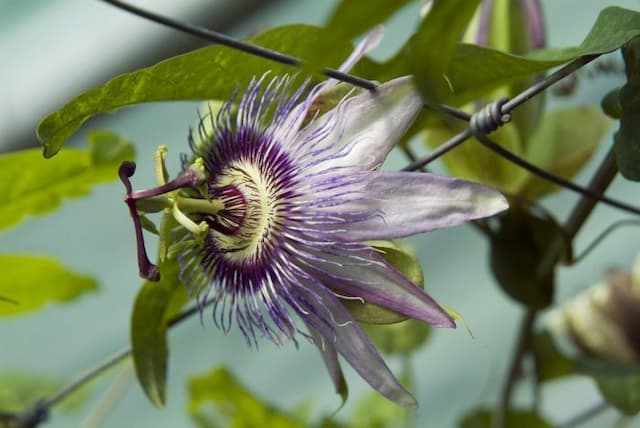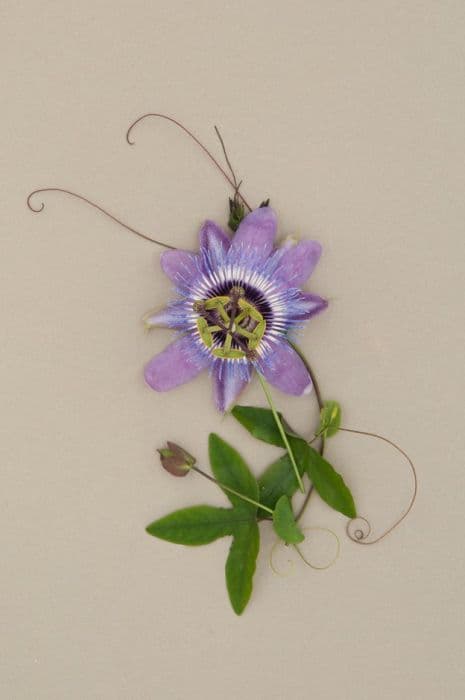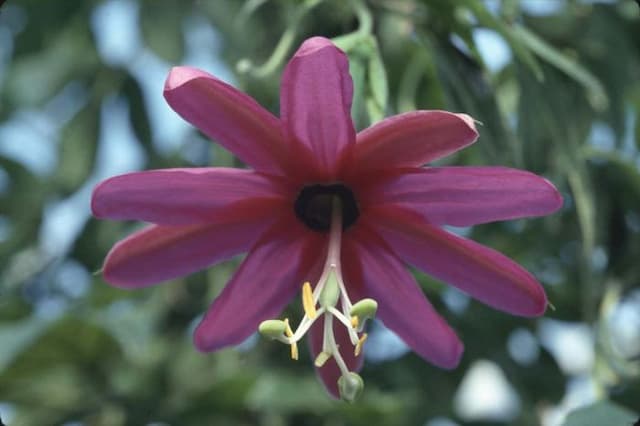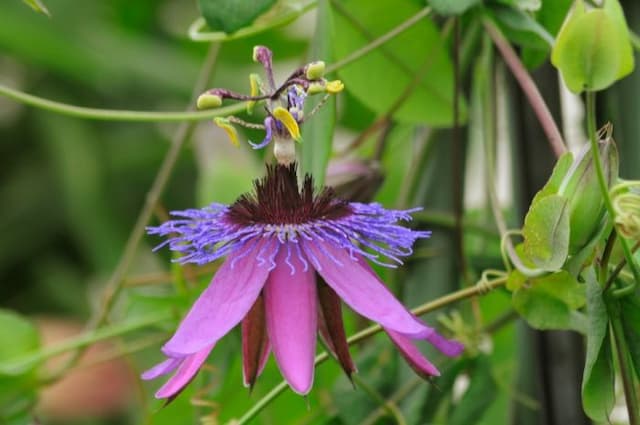Passion flower Passiflora 'Damsel's Delight'

ABOUT
Damsel's Delight is a member of the passion flower family, renowned for its unique and showy flowers. The plant boasts a vibrant display of blossoms that are particularly eye-catching. Each flower is composed of a white or creamy base color, overlaid with striking purple and pink stripes, giving it a star-like pattern. The central structure of the flower is a distinctive corona of thin, wavy filaments, which may range in color from white to purple, featuring a halo-like appearance that adds depth and texture to the bloom. The leaves of Damsel's Delight are deep green, often with a glossy surface, and have a lobed, sometimes serrated edge which adds to the plant's lush and tropical aesthetic. The vines of the plant may produce tendrils that allow it to climb and support itself on structures or other plants. These tendrils give the plant a graceful and spreading habit, which further enhances its visual appeal. In addition, this passion flower may bear oval-shaped fruit, which starts off as green and matures to a yellow or sometimes purple hue, depending on the variety. The overall appearance of Damsel's Delight makes it a captivating and exotic addition to any garden space, attracting not only human admirers but also providing a food source for pollinators such as bees and butterflies.
About this plant
 Names
NamesSynonyms
Damsel's Delight Passionflower, Passion Vine Damsel's Delight
Common names
Passiflora 'Damsel's Delight'.
 Toxicity
ToxicityTo humans
The Passionflower, in general, is not known to be toxic to humans when ingested in moderate amounts. Some species of Passionflower are used in traditional remedies and teas. However, large quantities or certain parts of the plant, such as unripe fruit, may cause gastrointestinal upset or discomfort. It is important to identify the specific variety and its properties before ingestion. If someone eats a significant amount of any part of a Passionflower plant and experiences symptoms such as nausea, vomiting, drowsiness, or an abnormal heart rate, they should seek medical attention.
To pets
Passionflower is not typically considered highly toxic to pets. However, as with humans, if a pet consumes a large amount of the plant, especially the unripe fruit, it might experience mild gastrointestinal discomfort, such as vomiting or diarrhea. In case of ingestion and the display of any concerning symptoms, it is advisable to consult a veterinarian. Generally, the plant is not expected to cause severe poisoning in pets.
 Characteristics
CharacteristicsLife cycle
Perennials
Foliage type
Evergreen
Color of leaves
Green
Flower color
Purple
Height
6-8 feet (1.8-2.4 meters)
Spread
3-5 feet (0.9-1.5 meters)
Plant type
Climber
Hardiness zones
9
Native area
South America
Benefits
 General Benefits
General Benefits- Aesthetic Appeal: The Passiflora 'Damsel's Delight', commonly known as Passion flower, offers striking flowers that can enhance the visual allure of any garden.
- Pollinator Friendly: Passion flowers attract bees, butterflies, and other beneficial pollinators, supporting biodiversity.
- Fast Growth: Passion flower vines are known for their rapid growth, which makes them ideal for quickly covering trellises, arbors, or fences.
- Shade Provision: With their dense foliage, Passion flower vines can provide natural shade in sunny areas.
- Edible Fruit: Some Passion flower varieties produce passion fruit, which is edible and can be a delicious addition to the home garden.
- Easy Propagation: Passion flowers can be easily propagated from cuttings, making it simple to expand your garden or share with others.
- Drought Tolerance: Once established, some Passion flower varieties exhibit drought tolerance, requiring less frequent watering.
- Suitable for Containers: Passion flowers can be grown in containers, making them suitable for balconies and patios.
- Wildlife Habitat: The dense vines can provide shelter for small wildlife, enhancing habitat opportunities in the garden.
 Medical Properties
Medical PropertiesThis plant is not used for medical purposes.
 Air-purifying Qualities
Air-purifying QualitiesThis plant is not specifically known for air purifying qualities.
 Other Uses
Other Uses- Butterfly Attractant: Passiflora 'Damsel's Delight', or simply passionflower, can be used in gardens to attract and support butterfly populations, providing nectar for adult butterflies.
- Natural Dye: The petals and fruit of the passionflower can be used to produce natural dyes for fabric or art projects, yielding various shades depending on the mordant used.
- Educational Tool: Passionflower's complex structure makes it an interesting plant for botanical study in educational settings, teaching pollination biology and plant anatomy.
- Privacy Screen: Passionflower can be grown on trellises or fences to create living green screens for privacy or to delineate garden spaces.
- Bee Forage: Due to its abundant nectar, passionflower can be grown to provide food for bees and other pollinating insects, aiding local ecosystems.
- Flavoring Agent: Though not commonly known, the fruits of the passionflower can be used as a natural flavoring in beverages or desserts, imparting a tropical taste.
- Arts and Crafts: Passionflower vines and flowers can be incorporated into floral arrangements, wreaths, and other decorative crafts for their unique appearance.
- Horticultural Therapy: Passionflower can be used as a tool in horticultural therapy programs, helping individuals improve mental and physical well-being through gardening.
- Photography Subject: With its striking beauty, passionflower provides a compelling subject for photographers, both amateurs and professionals, who are interested in plant and flower photography.
- Culinary Garnish: Edible varieties of passionflower may have flowers that can be used fresh as an exotic, edible garnish to add flair to dishes and desserts.
Interesting Facts
 Feng Shui
Feng ShuiThe Passion Flower is not used in Feng Shui practice.
 Zodiac Sign Compitability
Zodiac Sign CompitabilityThe Passion Flower is not used in astrology practice.
 Plant Symbolism
Plant Symbolism- Passion - The passiflora or passion flower is named so because it symbolizes Christ’s passion and the crucifixion, as its components resemble the crown of thorns, the wounds, and the nails.
- Christian Faith - Due to its association with the passion of Christ, the passion flower represents faith among Christians.
- Suffering and Glory - Again, tied to the crucifixion, the passion flower symbolizes the suffering before reaching glory.
- Sacrifice - The plant is often seen as a symbol of sacrifice because of its connection to the crucifixion narrative.
- Eternal Life - Its perennial nature and the way it comes back every year is seen as a symbol of resurrection and eternal life.
- Peace - The passion flower can also symbolize peace and calm, reflecting its sedative properties and the serene beauty of its blooms.
 Water
WaterPassionflower 'Damsel's Delight' should be watered deeply and less frequently, allowing the soil to become slightly dry between waterings. Typically, watering once a week with about 1 gallon of water is sufficient, but this may vary depending on climate and soil conditions. In hot or windy weather, the plant may need additional water. You can check the top inch of the soil; if it feels dry to the touch, it's time to water. Over-watering can lead to root rot, so ensure good drainage and avoid letting the plant sit in soggy soil.
 Light
LightPassionflower 'Damsel's Delight' thrives in full to partial sunlight, with at least 6 hours of direct sun exposure daily. An ideal spot would be in a bright, sunny area that receives morning sun and partial shade during the intense heat of the afternoon.
 Temperature
TemperaturePassionflower 'Damsel's Delight' prefers a temperature range between 60°F and 85°F. It can tolerate minimum temperatures down to around 50°F but won't survive long if exposed to frost conditions. It's important to protect the plant from temperatures below this range or above 95°F as extreme temperatures can impede growth.
 Pruning
PruningPruning Passionflower 'Damsel's Delight' is crucial for maintaining the plant's shape and encouraging new growth. Prune in early spring before the onset of new growth by removing dead or overgrown branches. This also helps to improve air circulation and light penetration. Pruning can be done annually or biennially as needed.
 Cleaning
CleaningAs needed
 Soil
SoilPassionflower 'Damsel's Delight' thrives in well-draining, fertile soil with a pH between 6.5 and 7.5. A mix of peat, loam, and perlite or sand works well to ensure adequate drainage and aeration. Regularly amend the soil with compost to maintain fertility.
 Repotting
RepottingPassionflower 'Damsel's Delight' should be repotted every 2 to 3 years to freshen the soil and accommodate root growth. Best done in spring or early summer, choose a pot only slightly larger than the previous one.
 Humidity & Misting
Humidity & MistingPassionflower 'Damsel's Delight' prefers moderate to high humidity, ideally between 40-60%. Maintaining proper humidity is crucial for healthy growth, especially when grown indoors.
 Suitable locations
Suitable locationsIndoor
Provide bright light and support for climbing.
Outdoor
Full sun to partial shade, protect from frost.
Hardiness zone
9-11 USDA
 Life cycle
Life cyclePassiflora 'Damsel's Delight', commonly known as Passion Flower, begins its life cycle as a seed, which, when sown in well-draining soil and provided warmth, will germinate, typically within a few weeks. After sprouting, the seedling enters a period of growth, developing its distinctive lobed leaves and vining stems. As the vine matures, it starts to climb using tendrils, and within a year, depending on conditions, will start to bloom, producing its intricate purple and white flowers. Following pollination, which is often assisted by bees and other insects, the passion flower will set fruit, usually egg-shaped berries called passionfruits. When fully ripe, the fruits drop to the ground, where they can release seeds to start the life cycle anew if conditions are favorable. Throughout its lifetime, which can be perennial in tropical climates or grown as an annual in cooler regions, the plant requires regular pruning to maintain health and vigor.
 Propogation
PropogationPropogation time
Spring-Early Summer
Propogation: The most popular method of propagating the Passionflower 'Damsel's Delight' is through semi-hardwood cuttings. This technique is typically carried out in late spring or early summer when the plant's growth is vigorous and healthy. To propagate by cuttings, a gardener would select a semi-hardwood stem segment that has several leaves and is about 4 to 6 inches (approximately 10 to 15 centimeters) long. The lower leaves should be removed, and the cut end may be dipped in rooting hormone to encourage root growth. The cutting is then placed in a pot with well-draining soil, kept moist, and covered with a plastic bag or dome to maintain high humidity until roots form, which can take several weeks. Once rooted, the cuttings can be transferred to individual pots and gradually acclimatized to normal growing conditions.









